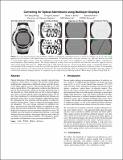| dc.contributor.author | Huang, Fu-Chung | |
| dc.contributor.author | Lanman, Douglas R. | |
| dc.contributor.author | Barsky, Brian A. | |
| dc.contributor.author | Raskar, Ramesh | |
| dc.date.accessioned | 2013-08-21T17:32:39Z | |
| dc.date.available | 2013-08-21T17:32:39Z | |
| dc.date.issued | 2012-11 | |
| dc.identifier.issn | 07300301 | |
| dc.identifier.uri | http://hdl.handle.net/1721.1/79898 | |
| dc.description.abstract | Optical aberrations of the human eye are currently corrected using eyeglasses, contact lenses, or surgery. We describe a fourth option: modifying the composition of displayed content such that the perceived image appears in focus, after passing through an eye with known optical defects. Prior approaches synthesize pre-filtered images by deconvolving the content by the point spread function of the aberrated eye. Such methods have not led to practical applications, due to severely reduced contrast and ringing artifacts. We address these limitations by introducing multilayer pre-filtering, implemented using stacks of semi-transparent, light-emitting layers. By optimizing the layer positions and the partition of spatial frequencies between layers, contrast is improved and ringing artifacts are eliminated. We assess design constraints for multilayer displays; autostereoscopic light field displays are identified as a preferred, thin form factor architecture, allowing synthetic layers to be displaced in response to viewer movement and refractive errors. We assess the benefits of multilayer pre-filtering versus prior light field pre-distortion methods, showing pre-filtering works within the constraints of current display resolutions. We conclude by analyzing benefits and limitations using a prototype multilayer LCD. | en_US |
| dc.description.sponsorship | National Science Foundation (U.S.) (Grant IIS-1116452) | en_US |
| dc.description.sponsorship | Alfred P. Sloan Foundation (Research Fellowship) | en_US |
| dc.description.sponsorship | United States. Defense Advanced Research Projects Agency (Young Faculty Award) | en_US |
| dc.description.sponsorship | Vodafone (Firm) (Wireless Innovation Award) | en_US |
| dc.language.iso | en_US | |
| dc.publisher | Association for Computing Machinery (ACM) | en_US |
| dc.relation.isversionof | http://dx.doi.org/10.1145/2366145.2366204 | en_US |
| dc.rights | Creative Commons Attribution-Noncommercial-Share Alike 3.0 | en_US |
| dc.rights.uri | http://creativecommons.org/licenses/by-nc-sa/3.0/ | en_US |
| dc.source | MIT Web Domain | en_US |
| dc.title | Correcting for optical aberrations using multilayer displays | en_US |
| dc.type | Article | en_US |
| dc.identifier.citation | Fu-Chung Huang, Douglas Lanman, Brian A. Barsky, and Ramesh Raskar. 2012. Correcting for optical aberrations using multilayer displays. ACM Trans. Graph. 31, 6, Article 185 (November 2012), 12 pages. | en_US |
| dc.contributor.department | Massachusetts Institute of Technology. Media Laboratory | en_US |
| dc.contributor.department | Program in Media Arts and Sciences (Massachusetts Institute of Technology) | en_US |
| dc.contributor.mitauthor | Lanman, Douglas R. | en_US |
| dc.contributor.mitauthor | Raskar, Ramesh | en_US |
| dc.relation.journal | ACM Transactions on Graphics | en_US |
| dc.eprint.version | Author's final manuscript | en_US |
| dc.type.uri | http://purl.org/eprint/type/ConferencePaper | en_US |
| eprint.status | http://purl.org/eprint/status/NonPeerReviewed | en_US |
| dspace.orderedauthors | Huang, Fu-Chung; Lanman, Douglas; Barsky, Brian A.; Raskar, Ramesh | en_US |
| dc.identifier.orcid | https://orcid.org/0000-0002-3254-3224 | |
| dspace.mitauthor.error | true | |
| mit.license | OPEN_ACCESS_POLICY | en_US |
| mit.metadata.status | Complete | |
